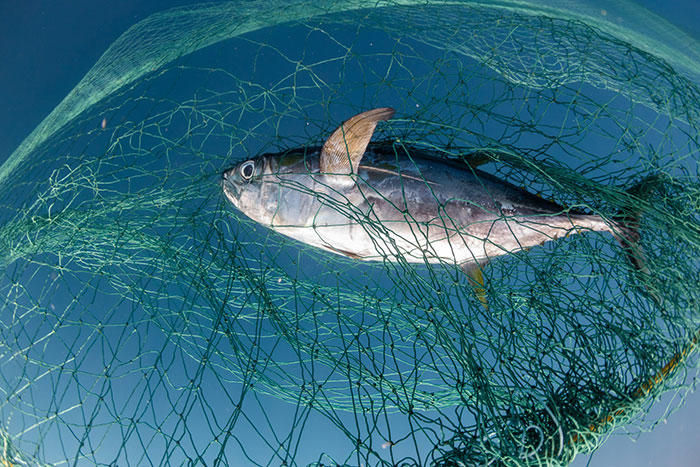Life below water

A juvenile yellowfin tuna that is entangled in a gill net off Sri Lanka’s coast highlights the impact of industrial-scale gill net fishing, which indiscriminately traps marine life and threatens tuna populations.
© The Ocean Story/Vincent KneefelA key milestone was progress towards the Agreement on Marine Biological Diversity of Areas beyond National Jurisdiction (the BBNJ Agreement), with 19 new ratifications bringing the total to 50 States – just 10 States short of the 60 needed for the Agreement to enter into force.
Sustainability challenges persist, but new data provide evidence that effective management drives progress
New global estimates based on expanded stock assessments reveal that 64.5 per cent of marine fish stocks were fished at biologically sustainable levels in 2021, while 35.5 per cent were overfished. This marks a modest improvement from previous estimates of 62.3 per cent for sustainably fished stocks. However, the share of overfished stocks continues to grow by about 1 per cent annually, highlighting the urgent need for more effective fisheries management. When considering catch volume, 77.2 per cent of global landings came from sustainably fished stocks, suggesting that high-yield fisheries tend to be better managed.
Regional variations are substantial. Well-managed areas, such as the Northeast and Southwest Pacific, showed high rates of sustainable fish stocks, at 92.7 and 85.5 per cent respectively, well above the global average. In contrast, the Mediterranean Sea, Black Sea and Southeastern Pacific face significant sustainability challenges despite recent progress.
Tuna fisheries exemplify successful management, with nearly all landings coming from sustainably managed stocks due to robust management efforts and regional cooperation. The findings demonstrate that effective and consistent fisheries management is key to reversing overfishing and securing sustainable fish stocks for the future.
Oceans reach record heat as coral bleaching crisis continues to unfold
The ocean absorbs around 90 per cent of the excess heat trapped by greenhouse gases, making it the planet’s largest heat reservoir. The World Meteorological Organization (WMO) confirms that in 2024, ocean heat content reached the highest level in 65 years of observations, continuing an eight-year streak of record-setting warming. Since 2005, the rate of ocean warming has more than doubled and is expected to continue rising throughout the century, even under future low-emissions scenarios. Sea-surface temperatures have also hit record highs across vast regions, including the tropical and North Atlantic, tropical Indian Ocean and parts of the western Pacific and Southern Ocean.
This warming is driving widespread and often irreversible marine ecosystem degradation. Coral reefs, home to a quarter of marine life and supporting approximately a billion people worldwide, are under severe stress. Rising ocean temperature caused by climate change is the primary cause of coral bleaching. The world is now in the midst of a fourth global coral bleaching event, which is considered the most widespread and intense on record. Between January 2023 and May 2025, bleaching-level heat stress affected 84 per cent of reefs globally, across 83 countries and territories. The bleaching event is so severe that coral mortality alert levels have been expanded beyond their original scale.
Repeated bleaching events and shrinking recovery periods are accelerating coral decline. From 2009 to 2018, 14 per cent of the globe’s coral cover was lost. Now 44 per cent of coral species face extinction. The Intergovernmental Panel on Climate Change warns that even if global warming is limited to 1.5°C, 70 to 90 per cent of warm-water reefs could vanish by 2050. At a 2°C warming limit, nearly all reefs would disappear, threatening biodiversity, food security and climate resilience.
Proportion of reefs bleached during global bleaching events, 1998, 2010, 2014-2017, and 2023-2025 (percentage)

Source: international Coral Reef Initiative
Ocean acidification is a rising global threat with diverse regional and local consequences
The ocean absorbs around a quarter of human-caused CO₂ emissions annually; while this helps to regulate the Earth’s climate, it results in acidification of ocean waters, threatening marine ecosystems and coral reefs, weakening coastal protection and food security and limiting the ocean’s future carbon uptake. Ocean pH has steadily declined across all ocean basins and seas. According to WMO, the average ocean pH has decreased from 8.1 in 1985 to 8.04 in 2023 (or -0.017 pH units per decade). Regional hotspots, such as the Indian, southern and eastern equatorial Pacific Oceans, are becoming acidified more quickly than the global average, while coastal areas show greater variability due to freshwater run-off, ice melt and nutrient pollution.
Monitoring efforts are expanding rapidly, with the number of observation stations increasing from 178 in 2021 to 765 in 2025. Still, significant data gaps remain, especially in coastal Asia, Africa, and open-ocean regions; this limits impact modelling and ecosystem vulnerability assessments. As acidification continues to intensify, expanding monitoring, particularly in undersampled coastal regions, is critical for understanding its impacts and informing targeted mitigation and adaptation strategies.
Calculated surface pH values based on representative sampling stations, 2010-2023 (pH total)

From treaties to tools, countries intensify response to illegal, unreported and unregulated fishing
Illegal, unreported, and unregulated (IUU) fishing remains a major threat to the sustainability of the world’s fisheries, undermining marine ecosystems, food security, and economies. IUU fishing accounts for up to 26 million metric tons of fish annually – about 15 per cent of global catches – and disproportionately harms small-scale fishers in coastal communities, reduces food availability and deepens poverty. It is also often linked to other illicit activities, including organized crime and forced labour.
Despite these challenges, countries are making measurable progress. Between 2018 and 2024, global implementation of key international instruments to combat IUU fishing improved from a medium to high rating (from 3 to 4 on a scale of 1 to 5). The share of highest-scoring (level 5) countries grew from 48 to 56 per cent. SIDS and LDCs, often challenged by vast maritime zones or limited resources, reached an average score of 4 by 2024.
Key instruments are driving this progress, including the Agreement on Port State Measures (PSMA), the first binding global treaty to specifically target IUU fishing. Now with 83 Parties, this Agreement covers 109 States. Other tools include voluntary guidelines on transshipment and the PSMA Global Information Exchange System, which enables vessel compliance data-sharing. Additionally, as of June 2025, the Agreement on Fisheries Subsidies of the World Trade Organization has been ratified by 102 members – just 9 short of entering it into force. While progress is encouraging, sustained global cooperation and full implementation of international instruments and tools are essential to close the net on the harmful impacts of IUU fishing.
States are moving beyond policy formulation and into the implementation of integrated ocean management
With ocean ecosystems increasingly threatened by climate change, pollution and habitat loss, sustainable ocean management has become essential. Countries are advancing ecosystem-based approaches, such as marine spatial planning (MSP) and integrated coastal zone management (ICZM), which link terrestrial and marine policies to build resilience, reduce conflicts and optimize the use of ocean space. MSP supports inclusive, transparent decision-making and is evolving to better integrate climate change and biodiversity considerations, from habitat protection to sustainable blue-economy planning.
In 2023, 126 countries and territories were engaged in MSP initiatives, a 20 per cent increase from 2022, with significant progress in Africa and Oceania. However, only 45 countries have formally approved marine spatial plans, underscoring the need for more capacity-building and stronger policy integration. Since 2015, efforts have shifted from policy formulation to implementation, with Europe and Northern America advancing adaptive management, while many countries in sub-Saharan Africa and Latin America remain in the early planning stages.
Key challenges persist, especially in developing regions; these include data gaps, limited institutional coordination and insufficient financing. To achieve healthy and productive oceans, stronger commitment, cross-sectoral integration, and adaptive governance are needed. Scaling up ICZM and MSP will help secure the long-term future of marine ecosystems and the communities that depend on them.
Number of marine spatial plans, by implementation level, 2023


